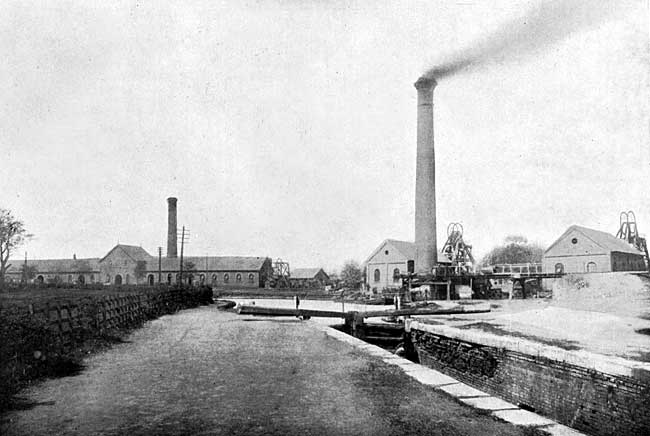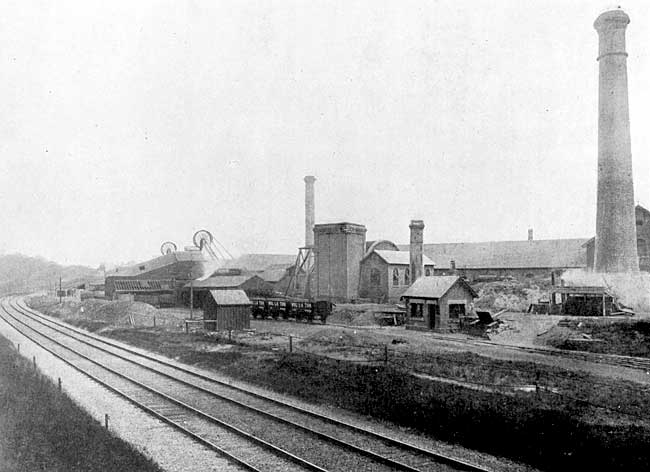< Previous | Contents | Next >
THE WOLLATON COLLIERY CO., LIMITED,
The Collieries, WOLLATON, near NOTTINGHAM.
THE prosperity of Nottingham's staple trades and manufactures is so inseparably dependent upon obtaining an abundant supply of coals suitable for the requirements of steam power users and for other industrial and domestic purposes, that a work dedicated to these subjects would be necessarily incomplete did it not include some particulars of the auxiliary works of production by which this indispensable requisite is procured. With this object, we select as thoroughly representative of the great industry of the Nottingham coalfield, the large and important undertaking of the Wollaton Colliery Company, Limited, of which we are enabled, by the courtesy of the Directors, to submit a brief descriptive account from materials placed at our disposal by the management.

The Wollaton Colliery from the Canal.
The Company was formed about a quarter of a century ago with the object of acquiring and working the minerals leased from the Right Hon. Lord Middleton, of Wollaton Park, giving an extent of coalfield of about 3,000 acres. The present Board of Directors comprises:—Sir James Reckitt, Bart, Chairman; E. H. Fraser, Esq., William Dawson, Esq., Managing Director; Frank Wright, Esq., and Harold Reckitt, Esq., M.P. The colliery is situated in the charming rural district from which it derives its title, about three and a half miles west of Nottingham. The Wollaton shafts are sunk wholly through middle coal measures, but one of them—No. 3—has been sunk deeper into the lower coal measures. The series of workable coal seams passed through in the shafts extends from the Top Hard or Barnsley bed to the seam known as the Piper coal of Derbyshire, this seam being about 208 yards in depth. The Wollaton shafts are respectively named the east or No. 1, the middle, and the west shafts. The sinking of the two larger shafts was commenced in June, 1873, and completed in August, 1874. The east and middle shafts are downcasts, each 14 feet diameter, 210 yards in depth, and 40 yards apart. The west shaft is the upcast, 12 feet diameter and 70 yards distant on the west from the middle shaft, is sunk to a depth of 500 yards, and bored further about 100 yards, making about 600 yards explored with the object of proving the Kilburn and other seams which are being worked in the district.

The Wollaton Colliery from the Railway.
The extraction of coal is now confined to the Deep Soft, 2ft. 10in. in thickness, and the Deep Hard Seam, 4ft. 6in. in thickness at the present workings, lying 14 yards apart one from the other. From the Deep Soft three qualities of large house coal are obtained, and four sizes of small coal. From the Deep Hard Seam three qualities of large steam coal are obtained, viz., top of seam (inferior steam) ; close-grained, middle (best steam) open grain, bottom (house coal). The mechanical equipment of the Colliery is of the most improved modern type, the winding plant comprising duplicate engines at No. 1 and No. 2 shafts, both having been erected by Messrs. Manlove, Alliott and Co., of Nottingham. No. 2 engine, when in full operation, has capacity for raising 1,200 tons of coal per day of eight and a half hours. It has two horizontal cyclinders 30in. diameter, 5½ft. stroke, the valves being of the double-beat type, worked by ordinary link motion. The drum, which is 14 feet in diameter, has a brake ring at each side acted upon by a foot brake and straps on the underside. The drum is constructed wholly of cast iron, having three sets of arms with segments at.the top, to which the lagging is bolted. This engine, with a steam pressure of 45lbs., raises two tubs in each cage with one deck, a tub carrying 16 cwt. of coal on an average. The winding ropes are of improved crucible steel 1¼in. diameter. The conductors are wire ropes, three to a cage. The weight of a cage with six bridle chains is 30 cwt., and the load is raised and the tubs changed in 30 secs. The winding engine at No. 1 shaft is principally employed in changing the miners and sending down materials, but in the busy winter season the two engines are capable of raising 2,000 tons of coal in eight and a half hours winding. The winding apparatus at No. 3 shaft is a winch with two 6in. diagonal cylinders used for shaft repairs.
Another important feature of the arrangements are the two air compressors on the surface, placed side by side, constructed by Messrs. Walker, of Wigan, and working on the compound and condensing principle. The high-pressure steam cylinder is 38m. diameter, with 6ft. stroke, and the low pressure cylinder 60in. diameter and 6ft. stroke, the pressures being respectively 50lb. and 251b. to the square inch. The air-compressors are each 40m. diameter, and the fly wheel is 25ft. diameter, and weighs twenty tons. The engines are usually worked at a speed of eighteen revolutions per minute. The air has a pressure of 18 to 20lbs. on leaving the compressing cylinders, equal to about 1¼ atmospheres effective. The condensing engine has one horizontal cylinder 16in. by 4ft., working two double-acting horizontal air pumps 16in. by 3ft., and the shop engine is placed in the same house, its dimensions being—one cylinder 13m. by 2ft. stroke. Steam is generated in six Lancashire boilers of iron 30ft long by 7ft. diameter, most of which were constructed by Mr. J. Whitehouse, of Ilkeston. The boiler-house chimney is 120ft. in height, circular in section, and 5ft. diameter inside. There are in addition eleven plain cylindrical boilers, 30ft. by 5ft. diameter, this battery being furnished with another lofty smoke stack 150ft. in height, circular in section, with inside diameter of 6ft. These supply altogether the steam for nine engines on the surface, besides three steam hoists. The ventilation is equally complete and efficient. The two seams are ventilated by a Guibal fan, 42ft. in diameter, 12ft. breadth of vanes, driven by a duplicated single engine alternately. Each cylinder is 30in. by 36m. stroke. The fan making thirty-five revolutions per minute produces 220,000 cubic feet of air with a water gauge 1.3in. The ventilating machinery was supplied by the Lilleshall Company. The underground hauling is effected by means of the compressed air already referred to, which is taken down the No. 3 shaft through 12in. pipes to actuate two pairs of hauling engines in the Deep Hard Seam. These engines are the same in dimensions, each having two horizontal cylinders 20in. diameter with 4ft. stroke, geared in a ratio of 2 to 1. The north side hauling engine is placed 150 yards from the shaft, and from each of the three clip pulleys power is transmitted by an endless rope, each traversing a separate haulage rope. The south side engine is arranged to work on similar methods, the ropes of some thousands of yards in length being fin. in diameter throughout.
The Wollaton field of coal is remarkable for the almost entire absence of faults to interrupt the working, and for the uniformity of dip of the coal measures, which is about 1 in 16 eastward. The system of working is by what is termed the "longwall," from the commencement in both seams, the gateways being driven for the most part on the level and 50 yards apart from centres. This method of working is known in other districts as the Nottingham system, the large tubs being taken along the face, about two-thirds to the rise and one-third to the dip from each gateway.
Mr. George Lewis, of Derby, is the consulting engineer.
Some hundreds of hands are employed in the collieries, under the supervision of Mr. Lot Hodgkinson, the colliery manager; the secretary to the company is Mr. J. Burrows. The illustrations incorporated with this notice represent two views of the colliery from the canal, and from the adjacent railway showing the trucks loading.
The Company are about to make large extensions, having purchased the Grove Estate at Radford, where they will at once commence sinking a shaft, erect the necessary engines, plant, and buildings, and having leased a large acreage of coal from Mr. Pearson Gregory, they practically own the coal comprised in the area between Radford and the Balloon houses, and from Strelley to the Derby turnpike. This extension will afford unequalled facilities for coal to be supplied expeditiously over the whole city of Nottingham.

